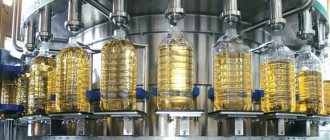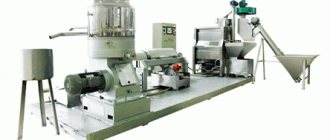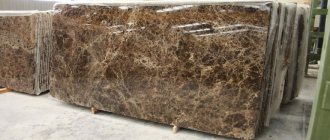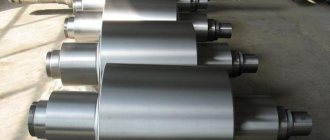The volumes of sunflower oil shipped for export reach new highs every autumn, increasing by 300 thousand tons per year. At the same time, prices for raw materials (about $300 per ton of sunflower seeds versus $780 per ton of oil on the world market) make it profitable not only to supply abroad, but also to produce vegetable oils for the domestic market. The features of the technology make it possible to organize a mini-churn at home or in an outbuilding, but a full-cycle enterprise will require large premises and significant capital investments.
This article discusses the intricacies of organizing an oil milling business both at home and with a full production cycle. Calculations show that any of the options has economic efficiency and high profitability, and the amount of profit depends only on the volume of production and investment.
Business relevance
Today, oil production in Russia is considered a fairly profitable industry. After all, it is exported to other countries where such a product is in significant demand. The bottled product is exported to Uzbekistan, and bulk oil is in great demand in Turkey.
The increased demand for these products is explained by the fact that they are widely used in a variety of fields: culinary, canning, medical, cosmetology, in the production of paints and varnishes for building materials and soap.
This branch of production is also popular due to the fact that it is essentially waste-free. After all, after the seeds are processed, in addition to the oil, there are also husks and cake, which can then be successfully sold for various needs.
An oil extraction enterprise is a very expensive project with an initial investment of at least twelve million rubles and a payback period of approximately three years.
If you open a small workshop with a production capacity of five to ten tons of product daily, then this will not require unnecessarily large expenses at the start. Here it is possible to fit in an amount of approximately three million rubles and gradually expand production capabilities by purchasing additional new technical equipment and increasing the volume of products.
Possible harm from consumption
The main point limiting the dose of unrefined varieties is their high calorie content (890 kcal/100 g) and the presence of a large amount of fat (99.9 g/100 g). It is not advisable to eat more than 3 tablespoons per day. Otherwise, the fat balance of the body, the functioning of its internal organs and systems will be disrupted, and weight will increase.
The frying process can produce toxins that are harmful to the body. People suffering from chronic diseases (hypotension, blood incoagulability, gall bladder problems, etc.) should consult a doctor about the permissibility of consuming oil or reducing doses. With some anomalies of the body, the positive properties of the product turn into negative ones. There are cases of allergies to sunflower oil ingredients. In addition, an expired product will cause harm.
IMPORTANT! It is not recommended to use unrefined sunflower oil in the diet of children under 2 years of age. This is a biologically active substance that can disrupt the formation of the child’s immune system.
Oil making equipment
Sunflower oil production equipment mainly consists of eight devices:
- Separator - with its help, seeds are separated from large impurities.
- The crushing machines grind the seeds to obtain mint.
- A roller mill is used for the same purpose.
- The roasting pan heats the mint. There are steam roasters (the mint is treated with steam) and fire (the mint is treated with heat).
- A screw press squeezes out the oil.
- Using a special filter, the pressed product is filtered.
- The extractor allows you to extract the remaining product.
- At the bottling line, the product enters the container.
Modern technical equipment makes it possible to obtain twenty thousand bottles of the product with a volume of one liter each from fifty tons of seeds in one hour. That is, from two and a half kilograms of sunflower seeds you can make one liter of oil. To service one production line, approximately ten to twelve workers will be required, including a technologist.
Is it possible to fry?
When choosing culinary recipes, housewives decide whether it is possible to fry in unrefined sunflower oil.
If there is no other option, then as an exception, once, it is possible. It should be taken into account that the vitamins will not be preserved, the taste and color of the oil will change, and the taste properties of the fried dish will also change. Some types of fish do not combine with the taste of unrefined varieties, and frying vegetables will ruin the taste of the soup. Cooks need to clearly understand why they cannot fry in unrefined sunflower oil all the time. Substances dissolved in oil, when heated, change their structure, are destroyed, and turn into toxins and carcinogens.
Main stages of raw material preparation
Today, sunflower oil can be produced using two main methods:
- oil production technology using screw presses;
- extraction technology (extraction method).
Small product manufacturers, as a rule, use cold-press technology. Its use does not bring increased volumes: in one hour, 38 liters of excellent quality product can be produced from one hundred kilograms of sunflower seeds.
The following main stages are distinguished, during which raw materials are prepared for the production process.
Cleaning
During the initial stage, sunflower is cleared of inorganic, organic and other types of impurities. For this purpose, separators, aspirators, and stone selectors are used. The raw materials are blown with air masses and sifted through a number of types of sieves. The mixture of seeds is separated taking into account the different indicators of its elements. Among them are the main ones:
- dimensional dimensions - sifting of the heap is carried out through sieve components with holes of different sizes, as a result of which different fractions are formed;
- aerodynamic parameters - the heap is separated due to the fact that the seed layers are intensively blown with air flow;
- ferromagnetic properties - the seed mass is cleaned from substances such as metal impurities.
The seeds must be subjected to high-quality cleaning: the proportion of debris should not be more than one percent, and broken grain should not be more than three percent.
Drying
Due to the fact that the seeds are conditioned by humidity, their technological properties are improved. To reduce the degree of humidity, the drying method is used directly in industrial dryers under the influence of saturated ventilation.
Shell separation
The seeds are sorted by size, peeled from the shell, and the core is crushed. The seeds are dehulled by hitting, squeezing, cutting or grinding them on a rough surface. Depending on which method will be used, such technical equipment must be purchased.
Seed processing
As a result of crushing the seeds and their petaling, a product called mint appears. Oil can be extracted from it with significantly less external influences than from whole seeds. The main goal of such processes is to completely destroy the cellular structure, achieve the optimal particle size and uniformity of the resulting mint.
During frying, the mint is treated with moisture and heat with intense mixing, its humidity and temperature conditions are brought to the best values. The result is a product called pulp.
Extraction
During the extraction method, in which oils are extracted, organic solvents are used (as a rule, these are special gasolines intended for extraction). The procedure is performed in special units called extractors. As a result, miscella is obtained - an oil solution in a solvent, as well as meal - a fat-free solidified residue. From them, the solvent is distilled off in distillers, as well as in screw evaporators. The resulting oil is settled, filtered and further processed. Extraction is distinguished by its cost-effectiveness, since thanks to it it is possible to extract fat from the placed raw materials to a level of ninety-nine percent.
The use of the extraction method is more common when compared to the churn method, since the resulting oil content in the material used is less than one percent. After extraction is completed, distillation is performed, the essence of which is that the solvent is pumped out of the miscella.
Filtration
The raw oil is filtered automatically on two plate filters that operate alternately in a cycle. To filter the oil, the product is fed from the mixer directly to the filters. The filtered product goes into a container. The press oil is cooled. Solid particles that are separated during the filtration procedure are sent again in the form of cake for pressing.
Compound
Unrefined sunflower oil contains a large amount of fatty acids.
Their average molecular weight is about 290 atomic units. A large share belongs to omega-9-oleic (25-40%) and omega-6-linoleic (45-60%) acids. The unrefined product also contains palmitic, stearic, myristic, arachidic, and omega-3-linolenic acids. Unrefined varieties are famous for containing vitamins that are preserved during the cold pressing process. Thus, α-tocopherol (vitamin E substance) is contained in amounts up to 70 mg/100 g. In olive oil, this figure is up to 24 mg/100 g.
It is a powerful neuroprotector and antioxidant; it protects cell membranes from damage due to oxidation, stabilizes mitochondria, regulates metabolic processes and immunity, and reduces the risk of malignant tumors. Another important vitamin in unrefined oil is K. The whole truth about flaxseed oil.
Production of refined sunflower oil
The technology for producing refined oil is as follows.
First stage: the seeds at the initial stage need to be cleaned of various types of impurities. The raw materials are settled, filtered, and centrifuged. After this, the vegetable oil can be sold as unrefined.
Second stage: the oils are treated with hot water (a temperature range of sixty-five to seventy degrees is used). This is done to remove phosphatides, or for hydration. After the oil is processed, the product becomes clear.
Third stage: free fatty acids are eliminated. If their level is excessive, the oil will taste unpleasant. After passing through three such stages, the oil is called refined, non-deodorized.
The fourth stage is bleaching, after which pigments and carotenoids are no longer present in the oil. The product is light-straw in color, deodorized, and has no odor. Volatile components are removed.
The fifth stage is freezing, during this process the waxes are removed. As a result, the oil becomes colorless and viscous.
After this, the resulting products can be stored for 4–12 months.
Is there any safe way to fry?[edit | edit code]
An alternative option is to fry in ghee. Ideally, if you melt it yourself manually. And you will do it right. Provided that recent studies have shown that the danger of butter for the cardiovascular system has been greatly exaggerated.
But it’s better, of course, to try not to fry at all. Instead of frying, you can stew foods! What is good about this method of cooking? And the fact that you no longer pour the oil into a clean frying pan, but into water, the temperature of which will not heat above 100 degrees.
You can fry in oil only if it is cold pressed. It has not yet undergone heat treatment, and when you fry, harmful substances do not form in it immediately. There is also oil made from high-oleic sunflower seeds - in this oil, even after several rounds of frying, carcinogens are not formed.
It’s better to add ordinary vegetable oil to salads. It must be unrefined: it contains several times more vitamins and nutrients than refined one.
Watch what kind of oil you buy in the store, try to choose preferably cold-pressed or simply unrefined and do not let the manufacturers deceive you!
Author: Ekaterina Ryzhkova
Packing
The production of vegetable oil requires high-quality packaging. Filling of the product into containers is usually carried out automatically on special production lines. Bottling is carried out in polymer bottles. They are marked and sealed. The bottles are hermetically sealed with aluminum caps with a thick cardboard lining and a cellophane surface. Containers made of polymer materials are sealed with polyethylene caps of slight compaction.
Shelf life and storage
The shelf life of unrefined sunflower oil, especially those that have not undergone mechanical refining, is quite short. It easily produces sediment and a cloudy color.
You should clearly remember how long unrefined sunflower oil is stored. After opening the package, the product should be used within a month. It should be stored in a glass container in a dark place at a temperature range of 5-25°C. If the color, smell or taste have changed, you should stop using the product. How to properly store bananas?
Review Reviews
Reviews of unrefined sunflower oil confirm that consumers are very fond of this product, which smells appetizingly like seeds.
Many people are not bothered by the fact that dishes acquire a specific taste and aroma. Another category of consumers prefers a culinary ingredient with a neutral taste and smell. Those who use the unrefined variety for frying say they don't spatter as much as the refined variety and the flavor is moderately pleasant in the finished dish. While cooking, the smell spreads throughout the house - this is an aroma that is not for everyone. More often, consumers season salads and boiled potatoes with unrefined oil.
Women use this product for cosmetic purposes for dry skin. For example, it helps well with corns. If you lubricate your feet with unrefined oil, wrap them in film and put on socks, your feet will be in good condition in the morning. Consumers complain that it is rare to find unrefined varieties on sale with a lively aroma of roasted seeds and a natural taste. Find out what the benefits of flaxseed oil are for women here.
Brief historical background
The birthplace of the product is North America. Sunflower was domesticated by the indigenous population of America, after which its products and the plant itself spread to other continents. In Europe, the product began to gain popularity in the 16th century; Oil came to Rus' much later - in the 18th century. Peter Ⅰ brought with him an overseas product after traveling to Holland. At first, peasants grew sunflowers simply for beauty. The solar plant attracted everyone with its aesthetic and bright appearance. Occasionally the seeds were used as food, but in general, only in 1829 did the plant begin to be used on an industrial scale. Oil mills were established throughout all provinces, which brought unprecedented income and popularity. The church also evaluated the product and recognized it as lean.
Medicinal use
As part of sunflower oil treatment, it is used in the form of pulling and rinsing. Both methods are known from followers of Indian medicine. Thanks to such techniques, you can eliminate bad breath, strengthen gums, increase immunity, and prevent fat from getting inside in the event of an allergic reaction.
Recommendations for using the method:
- Take 1-2 tablespoons of sunflower product.
- Rinse your mouth with it first for 5 minutes, then 10.
- Gradually increase the procedure period to 20 minutes.
- After the procedure, spit it out.
Rinse in the morning on an empty stomach, before brushing your teeth. During rinsing, it increases in volume, turns white and thickens.











